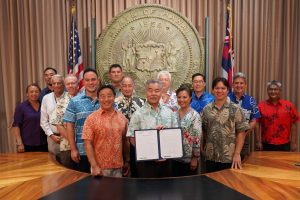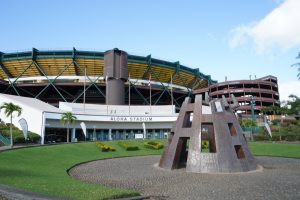Measuring progress in milestones statewide
Posted on Nov 27, 2019 in Capitol Connection, Featured
Governor Ige, legislators, UH and stadium officials gather for the signing of Act 268, appropriating construction funds as part of a New Aloha Stadium Entertainment District.
How do you measure progress? Sometimes it’s marked in headlines, other times with milestones that are under the radar. This issue recaps some major advances by the governor and his team over the past few months in housing, homelessness, infrastructure, sustainability and education. As we head into the holiday season, Governor and Mrs. Ige send their heartfelt message of Mele Kalikimaka and Hau‘oli Makahiki Hou to our Capitol Connection readers and everyone in the state.
Q. Why are Aloha Stadium redevelopment, airport modernization and a new Hawai‘i State Hospital facility so important?
A. Public infrastructure projects improve Hawai‘i’s quality of life overall for the future. They create jobs, provide economic stimulus and increase value for residents. A new stadium entertainment district will bring with it more retail, housing and other opportunities. The new state hospital building will provide better services for those with mental illness and a state-of-the-art facility to protect our workers. Improving airports statewide is important because they are such a vital part of our economy for both residents and visitors.
Q. Is there any progress to report on the Thirty Meter Telescope (TMT) situation?
A. More people are getting involved to help us with the complex issues associated with Mauna Kea — to find better ways to talk to each other as a community and bridge cultural divides. Mayor Kim’s document, “The Heart of Aloha,” describes a way forward that is beyond a “yes” or “no” on the TMT project. It describes what needs to be done so cultural, scientific and environmental interests in Hawai‘i can support each other. I have convened many of these discussions — with Native Hawaiian activists, community leaders and TMT partners. I know many people just want us to clear the Mauna Kea Access Road and the state is prepared to do that, but it has to be done in a way that ensures the safety of all involved. The TMT planners have agreed to many changes in the project to be respectful of Native Hawaiian concerns. They’re also creating jobs and providing educational support for Hawai‘i island. The challenge is to balance all of our people’s interests and concerns and decide how best to use public resources for the greatest community benefit.
Q. Why were changes in Department of Hawaiian Home Lands (DHHL) rules needed?
A. Getting people into homes is a priority, and providing affordable rentals, multi-family and other options expands what is available. Many beneficiaries have been offered leases but couldn’t afford the mortgage. These approaches give them a way to find housing, gain financial stability and move to a Hawaiian homestead opportunity. DHHL continues to make steady progress in awarding lots to families on the waitlist. Their latest offering provided 23 vacant lots in a subdivision east of Kapolei Parkway — the fourth lot selection DHHL has held since June. Over 1,300 lots are in the department’s pipeline for the next five years.
Q. What impressed you most about Emperor Naruhito’s enthronement in Japan?
A. It was such a once-in-a-lifetime opportunity and an honor to represent the United States as one of only seven Japanese-Americans invited. The ceremony, steeped in tradition, reflected the respect the people of Japan have for everything the emperor and empress represent. The strong relationship between Hawai‘i and Japan enabled me to be part of this historic event, and I’m grateful my administration has been able to maintain that vital connection.
